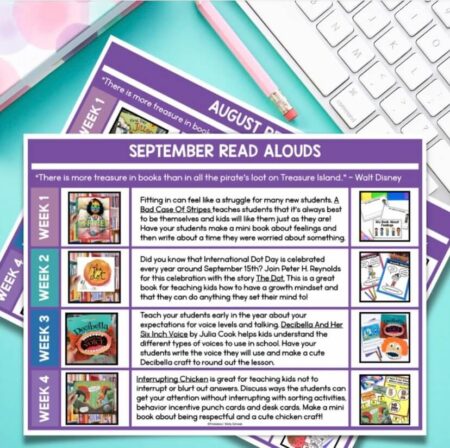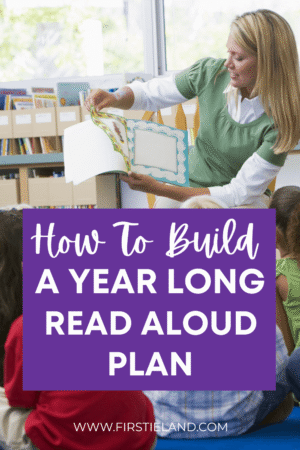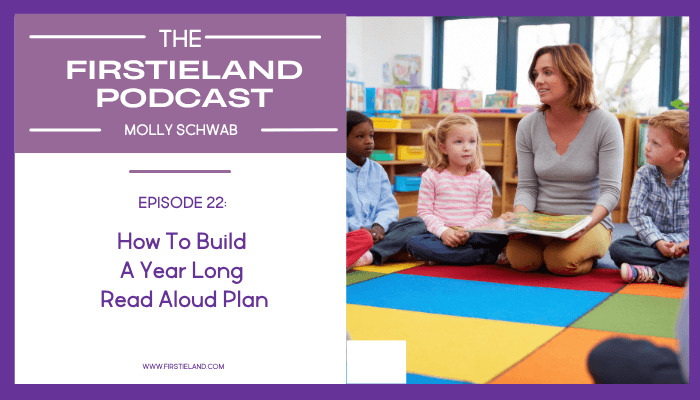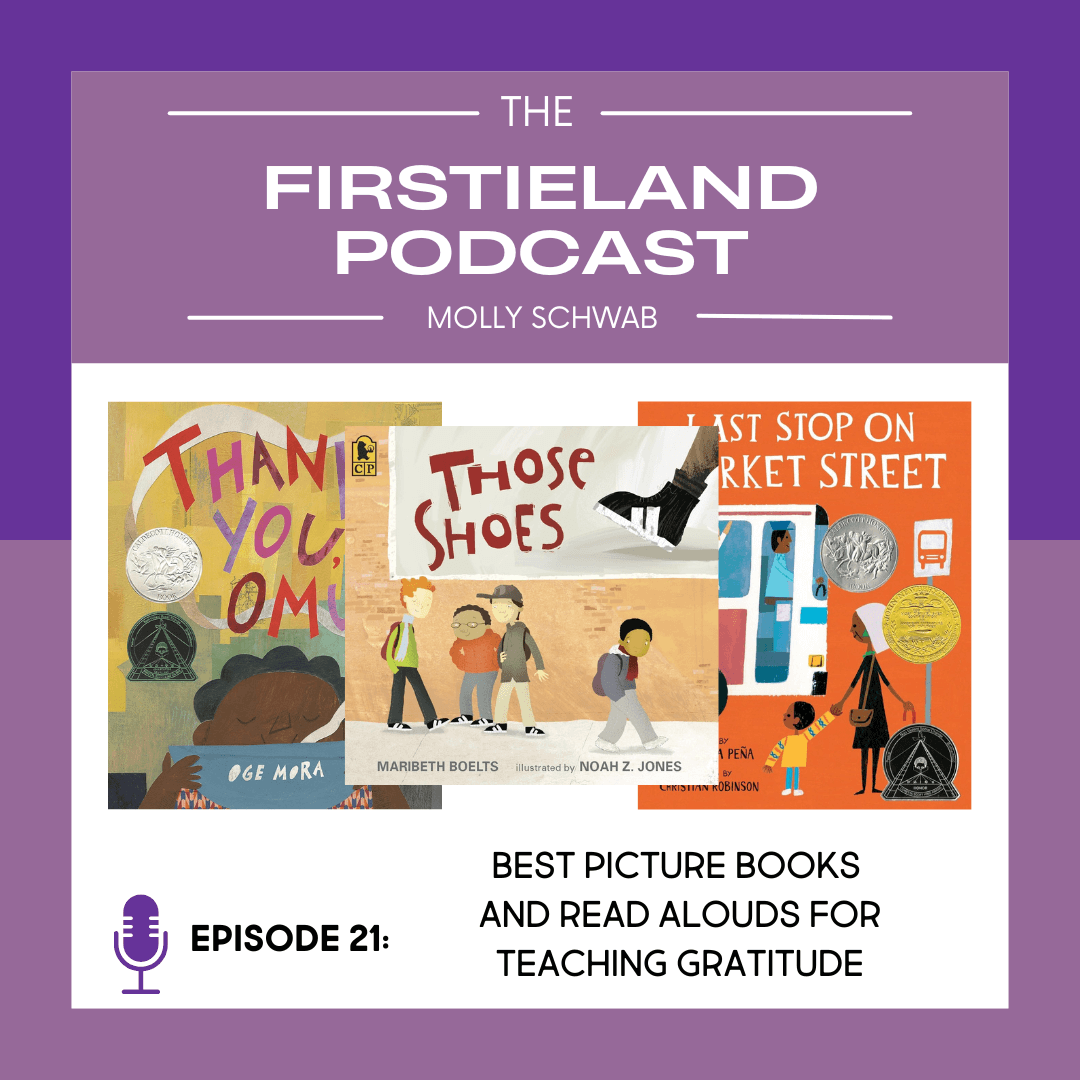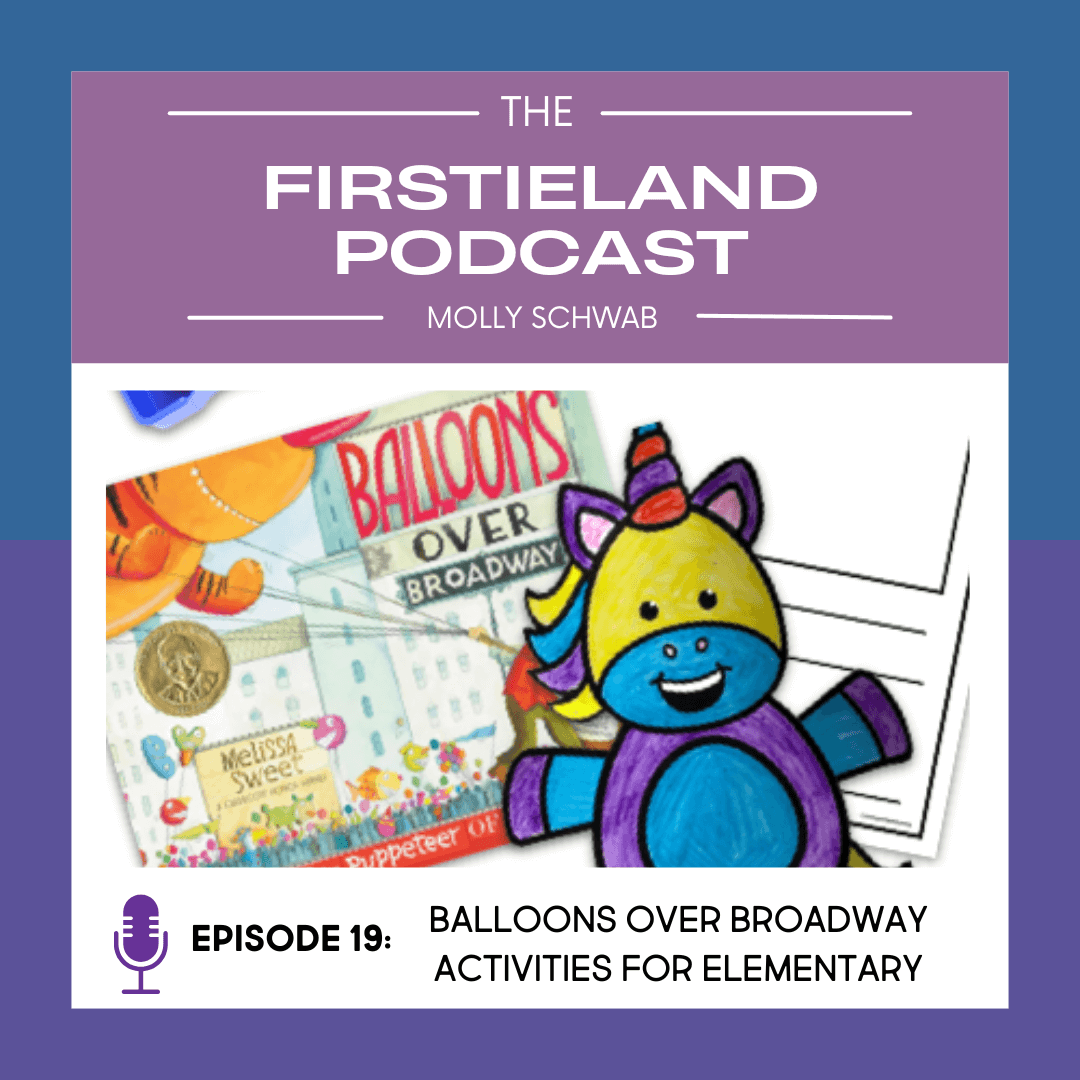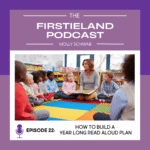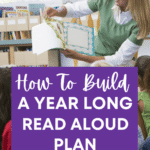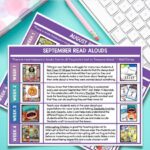[00:00:00]
Hey friends! Welcome back to the Firstieland Podcast. I’m your host, Molly Schwab. The other day I was heading to my son’s house to babysit my two granddaughters. I was in a rush because I was running late, but I wanted to take a couple of picture books with me. They love when I read aloud to them, and I knew they’d be disappointed if I showed up without any books.
So I rushed into my office and grabbed a couple of books off the shelf. It’s getting close to Thanksgiving, so I wanted something with turkeys. I have all my books arranged by month and theme on my bookshelf, so I found them quickly and was on my way.
As I was driving to their house, it made me think about how you, as teachers, can build your own read-aloud plan. Because here’s the truth — when you take a little time to map out your read-alouds for the year, you’ll never have to scramble at the last minute or wonder what book to pull. Instead, you’ll always have the right story ready to go that fits perfectly with the season and your curriculum.
So let’s take a look at how you can do that in your classroom.
[00:01:00]
Hey there, I’m Molly from Firstieland, a former elementary teacher with over 30 years of experience in kindergarten and first grade. I’m here to help make teaching a little easier and a lot more fun. Whether you’re looking for the perfect read-aloud, fresh writing ideas, or simple classroom tips, I’ve got quick, practical strategies you can use right away.
New teacher or experienced educator, there’s something for everyone in Firstieland. So grab your coffee and teacher bag — let’s get started!
[00:02:00]
Have you ever found yourself scrambling in the morning for the perfect read-aloud? Maybe your kids are interrupting a lot and you really want to read a story to help them understand why they shouldn’t interrupt. But you didn’t take time to research good books on that topic.
So you find yourself running down to the school library before school starts, searching for the perfect book, or asking your teacher bestie if she has one you can borrow. I remember one time I completely forgot it was Election Day. I wanted to do a quick lesson about how we elect our president, but I hadn’t written it into my plans.
I knew I had a couple of worksheets I could use, but I really wanted a picture book that would help me teach the concept. So there I was at 8:15, five minutes before my class arrived, Googling good picture books about Election Day. I found Grace for President, but I didn’t have it in my classroom library. I was scrambling around seeing if anyone had it or if it was in the school library.
Yeah, that kind of stuff isn’t fun — and you don’t want to be like me!
[00:03:00]
Having a plan for your read-alouds for the year means you won’t be caught off guard by holidays or teachable moments that sneak up on you. Instead, you’ll be prepared with the right book at the right time. Your lessons will feel more smooth and intentional instead of stressful and rushed.
By the end of this episode, I’m going to show you how you can map out a read-aloud plan for the entire school year that will save you time and reduce your stress.
So why does planning ahead matter?
Well, read-alouds aren’t always just for fun — though they can be, and you should have some time built into your schedule for reading just for enjoyment, with no strings attached. But your time is limited, and being more strategic with the picture books you choose can help you teach important standards through those read-alouds.
[00:04:00]
When you have a year-long plan for your read-alouds, it saves you from making last-minute decisions and choosing books that might not be high-quality or that don’t quite teach the skills you need.
When you make a year-long, quarterly, or even monthly plan, you can be sure you’re using high-quality picture books to reach your goals. It also ensures you’re including a variety of genres — not just fiction, but nonfiction, poetry, historical fiction, and biography.
Planning ahead helps you align your books with your curriculum and social-emotional goals.
For example, maybe you always teach “how-to” writing in October. You can choose books that lend themselves to that writing skill. Or maybe in February you focus on friendship, so you can plan ahead for books with that theme.
[00:05:00]
As an example, in November the themes I liked to include were fall, Thanksgiving, and gratitude. I was also teaching persuasive and informative writing, learning about why leaves change color in science, and covering reading comprehension skills like story elements, making text connections, and main idea — plus vocabulary.
My goal was to choose four books that covered all of those standards.
I chose Balloons Over Broadway because it’s a biography that ties in with informative writing and STEM skills.
I used A Turkey for Thanksgiving for persuasive writing and discussions about Thanksgiving traditions.
My third book was The Leaf Thief, which worked perfectly for teaching about fall changes.
And my final book was Thank You, Omu! for gratitude and being thankful.
All four books helped me teach comprehension skills like story elements and text connections. When I planned my read-alouds strategically, I could teach multiple standards with just four books.
[00:06:00]
These four books are all part of my November Read-Aloud Bundle in my TPT store — I’ll link it in the show notes.
So how can you create a year-long read-aloud plan?
First, decide on the framework you want to use. Are you going to do a weekly read-aloud or a daily one — or both?
Maybe you’ll choose one high-quality book each week that ties into reading, writing, science, or math and stretch it over several days with different activities. Or maybe you’ll also have a daily read-aloud time — like after recess or before dismissal — that’s just for fun, with no specific skill attached.
[00:07:00]
Once you’ve decided on your framework, decide on the themes or concepts you’ll want to teach each month.
For example, in September you might focus on building classroom community and teaching rules and routines, so you’ll choose books that support those goals.
In October, you might teach about fall and start exploring social-emotional skills like friendship and respect. In November, you might focus on gratitude and being thankful — in fact, I talked about five great picture books for that in Episode 21, so you can go back and listen to that after this one.
Or maybe in November you’re teaching about life long ago and the first Thanksgiving — perfect for nonfiction or historical fiction books.
Each month, think about your central themes and the reading, writing, math, science, and social studies skills you want to teach. Then find books that tie both together.
[00:08:00]
For instance, if you’re teaching informative writing in November, choose picture books that support that writing type and also connect to your seasonal themes like fall or life long ago.
This is how you strategically select read-alouds — not only do you get time to read to your students, but you also use those books to teach across the curriculum.
Your goal is to mix your monthly themes with your academic skills.
For example, if you’re teaching about insects in the spring, you might do an Eric Carle author study and read The Grouchy Ladybug, The Very Hungry Caterpillar, and The Very Clumsy Click Beetle. These books help teach insect life cycles in science and support informative writing.
[00:09:00]
Be sure to leave room for flexibility. I recommend choosing one main weekly read-aloud — about four per month — that connects to your skills and themes.
For daily read-alouds, you can be much more flexible. Create lists of books by theme — back-to-school, fall, holidays, etc. — and keep a monthly book basket near your carpet area. Let students pick or choose one yourself. Daily read-alouds don’t have to be as structured as weekly ones.
[00:10:00]
To stay organized, you can use a binder or calendar to map your monthly themes and book lists. I like to store my books by month for seasonal reads and also by theme (nonfiction, poetry, author, etc.).
I even had a file cabinet just for read-alouds, keeping specific books and their activities together. For example, at the beginning of the year I always read David Goes to School when we made classroom rules, and I kept all related worksheets and activities in my August file.
If you want to reread a book later, you’ll know right where it is. You can even keep sticky notes with discussion prompts or comprehension questions tucked inside each book.
[00:11:00]
Once you’ve created your plan, you can reuse it year after year. Even if you’ve done it before, it’s new for each group of students! If you find a new favorite book, just swap it in — but no need to reinvent the wheel.
Remember, the goal is to save time. Once you find a great book for a skill, stick with it.
To recap: when you plan your read-alouds ahead of time, you’ll save time, teach with more intention, and reduce stress for both you and your students.
[00:12:00]
If you’re new to this, start small — plan one month at a time. If you do a weekly read-aloud, that’s just four books and activities for the month. Then organize your materials digitally or in a file cabinet so everything’s ready to go each year.
If you keep at it each month, by next school year your entire plan will be finished!
So, first choose your framework. Then map it out by month or season. Balance your genres and weave in curriculum connections. Stay flexible with daily read-alouds, and organize everything by book and month for easy reuse.
[00:13:00]
If you want a head start, I have monthly book companions in my TPT store where I’ve done all the planning for you. Each set includes four books per month with lessons for reading comprehension, writing, math, science, and SEL. The plans are written — all you need are the books, which you can find in your library or on YouTube.
And for the best deal, you can grab the Year-Long Read-Aloud Bundle in my store — it’s deeply discounted. I’ll leave all the links in the show notes.
[00:14:00]
Okay friends, I hope this episode helped you decide how to plan your read-alouds for the year. Until next time — happy reading, and remember to make learning feel like play. See you next week!
Thanks so much for tuning in. I hope you’re walking away with some great tips you can use right away. Be sure to hit follow or subscribe so you never miss an episode, and if you’re enjoying the podcast, I’d love it if you’d leave a review.
You can find the show notes and all the links for this episode at firstieland.com.
See you next week in Firstieland!

